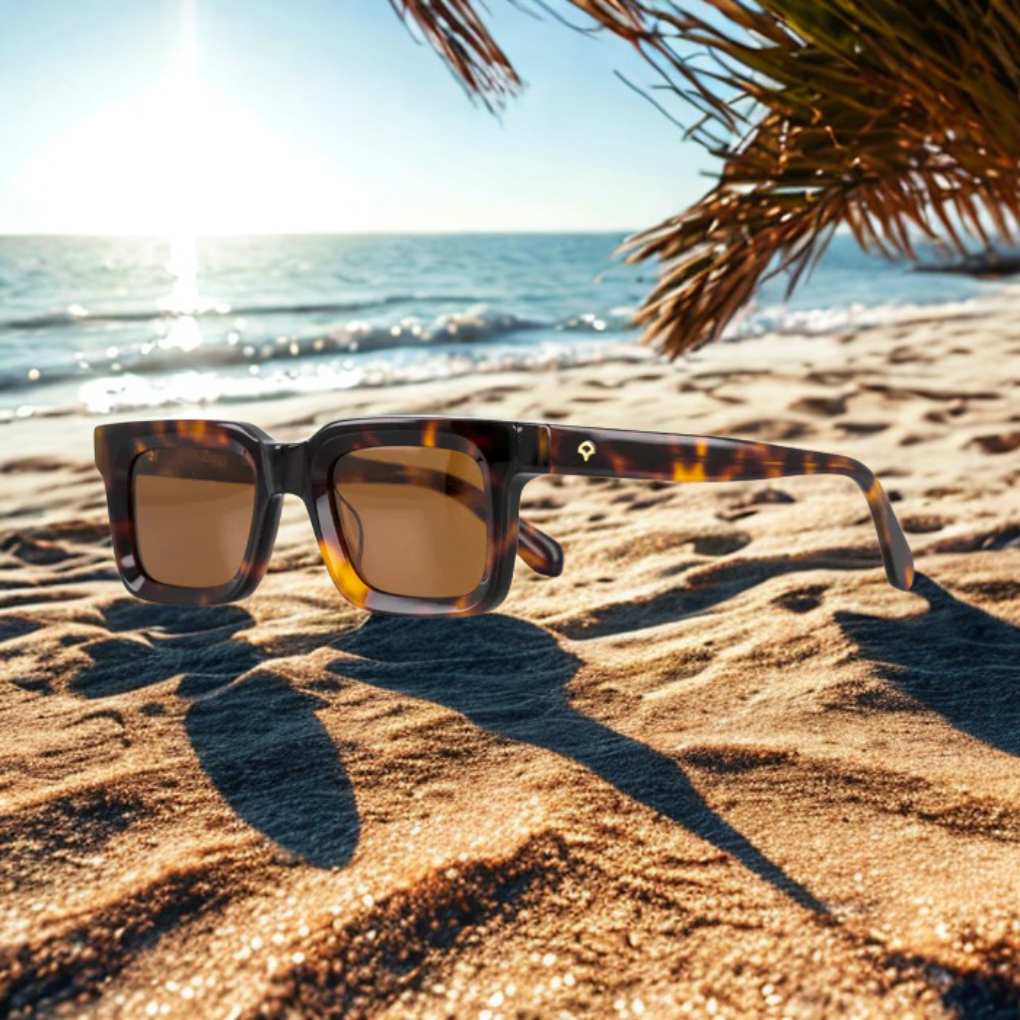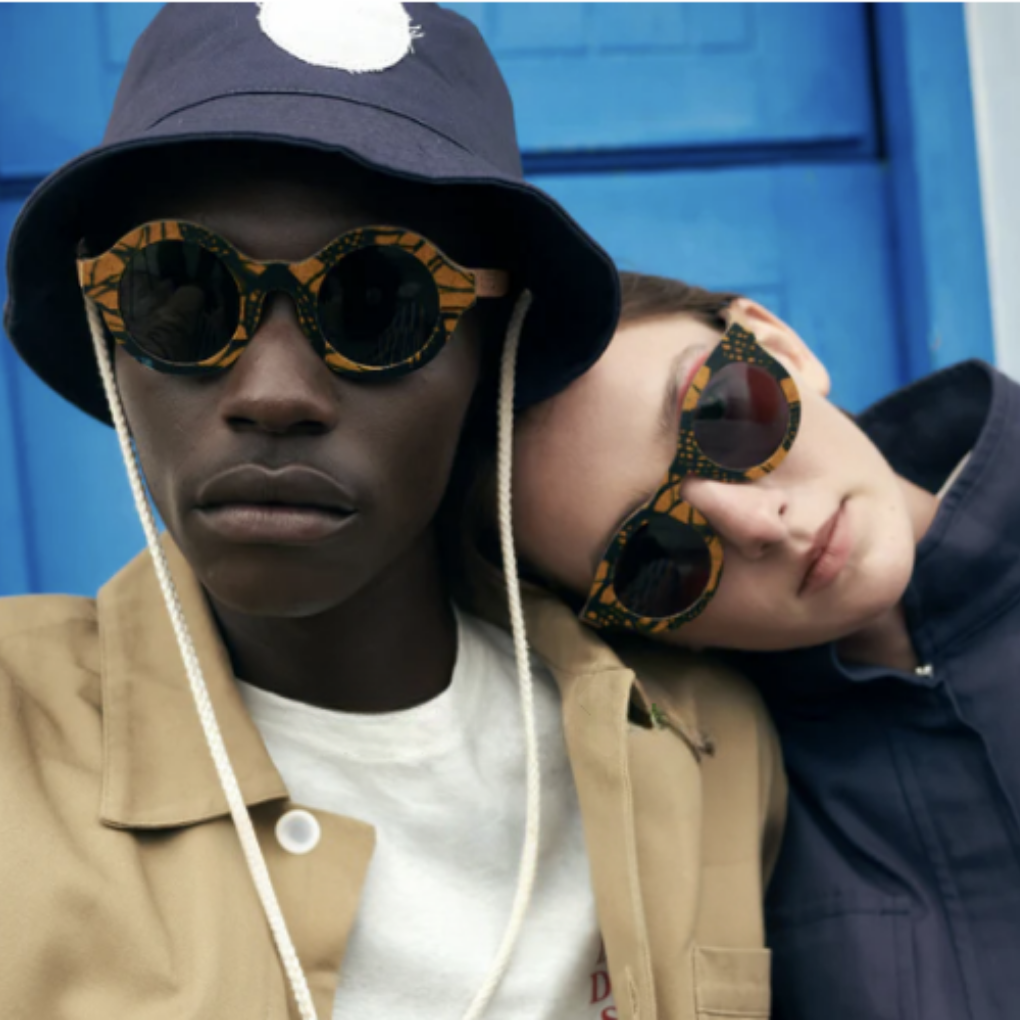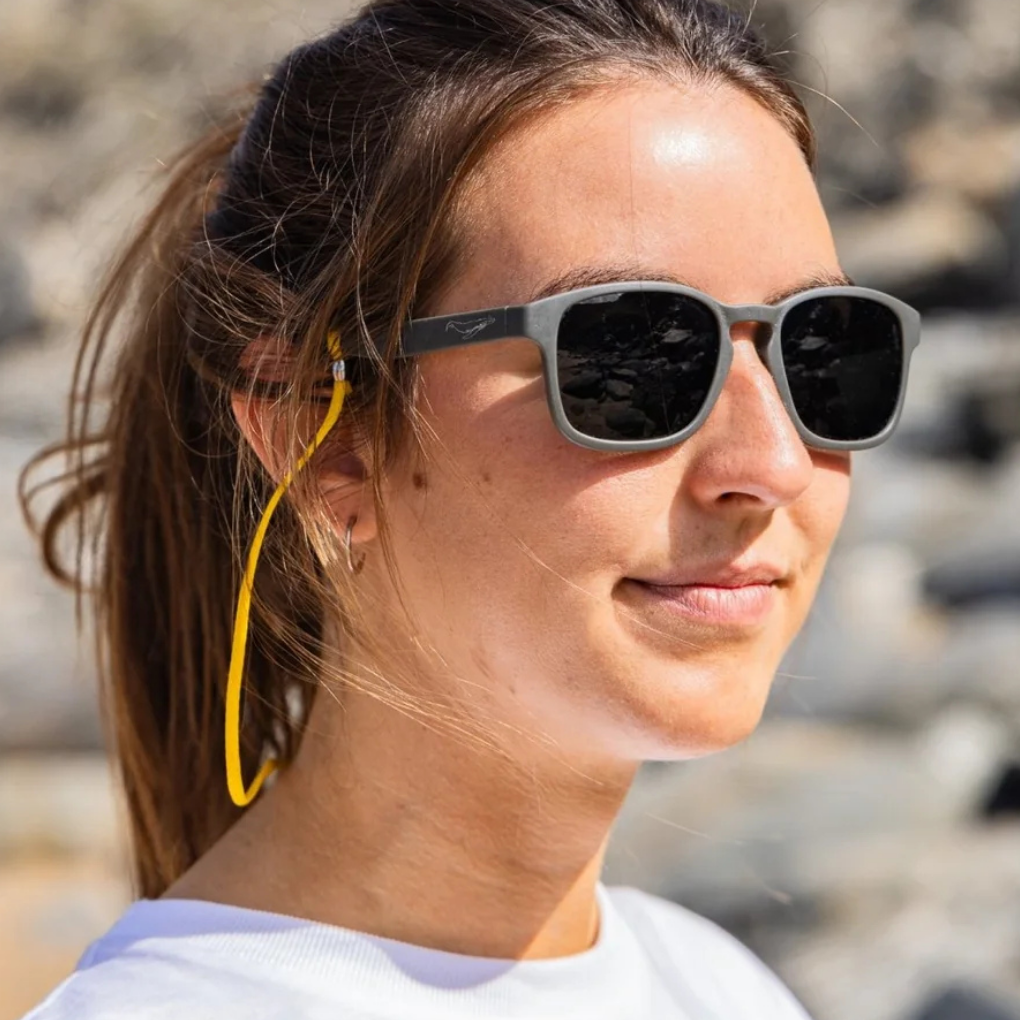
Key Takeaways
- Sustainable sunglasses use recycled plastics, bio-resins, bamboo, or cork instead of virgin plastics from fossil fuels.
- Choosing eco-friendly sunglasses helps cut plastic waste and reduces the risk of microplastics polluting oceans and landfills.
- Brands now combine style with responsibility—offering durable, polarized shades made with ethical and planet-friendly practices.
Sunglasses are a must-have, whether you’re at the beach, driving, or just soaking up some sun. Most of these sunglasses, however, are made from plastics that don’t break down easily. Every year, millions of pairs are discarded into landfills around the world.
The eyewear industry produces hundreds of millions of frames annually, with a significant portion made from virgin plastics such as polycarbonate, nylon, and plasticized acetate. These materials not only persist for a long time but also impose a significant environmental toll through carbon emissions and waste.
Thankfully, things are starting to shift. A growing number of brands are finding ways to use recycled plastics, fishing nets pulled from the ocean, and other sustainable materials to create sunglasses that not only look great but also help reduce waste.
In this post, we’ll introduce you to some of the best sustainable sunglasses brands out there. We’ll look at the materials they use, their sustainability missions, and how you can make a stylish choice that’s better for the planet. Ready to see how your next pair of sunglasses can make a difference? Let’s get started.
What Makes Sunglasses Eco-Friendly?
Eco-friendly sunglasses go beyond just style; they represent a commitment to protecting our planet. A key factor is the use of recycled, or non-virgin, plastics. Instead of relying on brand-new plastics made from fossil fuels, these sunglasses give new life to existing materials. This reduces plastic waste and lessens the demand for extracting raw resources, which helps shrink the overall environmental footprint.
But being sustainable doesn’t stop at the materials. It also means ensuring ethical manufacturing practices, such as fair labor conditions and minimizing pollution during production. Thoughtful packaging is another crucial piece of the puzzle, using recyclable, compostable, or plastic-free materials helps reduce waste after the product’s lifespan.
On top of that, many brands invest in environmental or social initiatives, from planting trees to supporting local communities, making eco-friendly sunglasses part of a bigger movement toward responsible consumption.
Key Materials Used in Eco-Friendly Sunglasses
Sustainable sunglasses rely on a variety of innovative materials that reduce environmental impact while maintaining style and durability. Here’s a closer look at some of the most common eco-friendly materials you’ll find:
Recycled Plastics
Many eco-conscious brands use recycled plastics as a primary material. This includes post-consumer plastics like old water bottles and packaging, as well as ocean plastics and discarded fishing nets. By repurposing these materials, brands help reduce plastic pollution in oceans and landfills while cutting down on the need for new plastic production. Recycled plastics can be molded into lightweight, durable frames that look just as good as traditional plastic.
Bio-Resins and Plant-Based Materials
Bio-resins are plastics made from renewable plant sources such as castor beans, corn, or sugarcane. These plant-based alternatives require less energy to produce and generate fewer greenhouse gases compared to petroleum-based plastics. Bio-resins also offer good flexibility and strength, making them a sustainable option for sunglasses frames.
Natural Materials: Bamboo and Cork
Bamboo is a fast-growing grass that requires minimal water and no pesticides, making it an eco-friendly choice for eyewear. Bamboo frames offer a unique, warm aesthetic and are biodegradable at the end of their life. Cork, harvested from the bark of cork oak trees without harming them, is another renewable material used for accents or entire frames. It’s lightweight, water-resistant, and biodegradable.
Sustainable Lens Materials and Coatings
The lenses in eco-friendly sunglasses can also be made from more sustainable materials. Some brands use recycled polycarbonate or glass lenses, which can be recycled at the end of their life cycle. Additionally, eco-conscious lens coatings reduce harmful chemicals and improve durability. For example, some coatings are free from toxic solvents and help lenses resist scratches, fog, and glare without harming the environment.
Now that you know what materials make sunglasses more eco-friendly, let’s look at why choosing these alternatives instead of traditional plastic frames makes such a big difference.
Why Buying Plastic Alternatives Matters
It might not seem like a big deal, but plastic sunglasses really add up when it comes to pollution. Every year, hundreds of millions of pairs are made, most from plastics like nylon and polycarbonate that come from fossil fuels. The problem is, once these sunglasses get tossed out, they can stick around for hundreds of years. As they slowly break apart, they release tiny bits called microplastics into our soil and water.
The Benefits of Choosing Alternatives
Opting for sunglasses made from recycled plastics, bio-resins from plants, bamboo, or cork helps break this cycle. Every pair you buy signals to the industry that sustainable options matter, creating more demand for innovation and reducing reliance on nonrenewable resources.
It’s also about what happens after their life span. Plastic frames often end up in landfills or incinerators, while bamboo, cork, or responsibly recycled materials can either biodegrade naturally or be reintroduced into a circular system. This not only keeps waste out of the environment but also reduces the carbon footprint tied to production and disposal.
By choosing plastic alternatives, you’re not just making a stylish choice—you’re taking a small but powerful step toward a cleaner planet. When multiplied across millions of consumers, these decisions can shift entire industries toward more responsible practices.
Don’t Miss: The Truth About Plastic: Why Plastic-Free Living Matters After you’ve found your perfect pair of eco-friendly shades, explore why cutting back on plastic products is so crucial for our planet. Read more →11 Stylish Shades with a Conscience
ℹ️ Heads up: Not all styles from each brand use the same materials. Be sure to double-check product descriptions to confirm what’s used in the specific pair you’re eyeing.
Zeal Optics
$130–259

Zeal Optics has been making sunglasses since 1997 from their home base in Boulder, Colorado, where the mountains meet a community that lives and breathes the outdoors.
Their designs are built for people who are always on the move, whether that’s hiking a trail, paddling out on the water, or exploring the city.
Most of their frames are made from Z-Resin, a lightweight, durable plant-based material made from castor bean oil that contains plant-based content.
The lenses are plant-based too, polarized for sharp clarity and designed to reduce reliance on fossil-fuel-based plastics.
Even their packaging is eco-friendly, using FSC-certified paper and cutting out single-use plastics completely.
- Material: Z-Resin (plant-based castor bean frames), See Grass (agricultural grass fiber + recycled plastic composite), plant-based polarized lenses
- Certifications: 1% for the Planet, FSC-certified
Ballo Eyewear
$75-150

Ballo Eyewear started in 2013 in Cape Town, South Africa, with a clear mission: to make stylish, eco-friendly glasses that do good for people and the planet.
Their frames are crafted from unique recycled and renewable materials like cork, wood offcuts, and even plant-based biodegradable acetate, giving each pair a one-of-a-kind vibe.
But Ballo isn’t just about great design. Every pair sold helps a schoolchild in South Africa through their “BUY 1 GIVE 1” program, providing glasses to kids who need them.
They also team up with groups like GreenPop to plant trees and educate communities, all while running a carbon-neutral business that actively offsets its impact.
- Material: Recycled cork, wood offcuts, recycled paper, fabric offcuts, plant-based biodegradable acetate
- Certifications: B Corporation, 1% for the Planet
Proof Eyewear
$60–150

This Idaho-based eyewear brand was started in 2010 by the Dame brothers Tanner, Brooks, and Taylor who grew up around their grandfather’s sawmill. Their love for quality craftsmanship and nature shines through in every pair they make.
What makes them truly stand out is their profound commitment to sustainability and giving back. They use materials like FSC-certified wood, biodegradable cotton-based acetate, recycled aluminum, and even repurposed skateboard decks to keep their environmental footprint low.
Their “Do Good Program” is a big part of the story. They donate 12 percent of their profits to global causes, and since 2021, they’ve been planting five trees for every frame sold. The packaging is just as thoughtful, with cases made entirely from pine wood to reduce landfill waste.
- Material: FSC-certified wood, biodegradable cotton-based acetate, recycled aluminum, repurposed skateboard decks
- Certifications: FSC-certified wood (Forest Stewardship Council)
Pala
$140–160

Pala is a sustainable eyewear brand based in Brighton, UK, that launched in 2016 with a clear goal: to improve eyecare access across Africa.
What’s special about Pala is that every pair you buy helps support Vision Aid Overseas. That means funding programs that bring vision centers, eye exams, and training to communities.
Their frames are handcrafted in small batches in Italy using biodegradable, plant-based bio-acetate, so you know they’re kind to the planet. The cases are just as impressive, hand-woven in Ghana by female artisans from recycled plastic waste, blending style with real social impact.
They’ve thought about every detail, from soft bags made with 70 percent recycled PET to packaging that’s plastic-free, FSC-approved, printed with vegan ink, and fully recyclable. Plus, in the UK, Pala offers a take-back recycling program through TerraCycle to keep eyewear materials in a circular loop.
- Material: Bio-acetate frames, recycled PET soft bags, recycled plastic woven cases, plant-based resin lenses (around 39% plant origin), nickel-plated recyclable steel hardware, FSC-approved and recyclable packaging
- Certifications: B Corporation, FSC-certified packaging
CHPO Eyewear
$40-120

CHPO started in Sweden back in 2013, inspired by the energy of skateboarding, music, and art. Their motto, “Made for Everywhere,” really sums up their vibe, creating accessible, socially responsible, and sustainable designs that anyone can enjoy.
They make sunglasses and watches using recycled materials and vegan-friendly components, with packaging that’s biodegradable too.
Their sunglass frames are crafted from 100% recycled plastic, certified by the Global Recycled Standard, and their watch straps use vegan leather alternatives like polyurethane and recycled nylon.
You’ll also find “ReSteel” in their metal frames and watch parts, which is their name for recycled stainless steel. Even their packaging is eco-friendly, with pouches made from recycled PET bottles and plastic bags made from corn-based biodegradable plastic.
Shipping is carbon-neutral thanks to Shopify Planet, which offsets emissions from deliveries. Plus, CHPO teams up with nonprofits like Skateistan, WDC, Make Equal, The Ben Raemers Foundation, and Skate Pal.
- Material: 100% recycled plastic or recycled stainless steel frames, lenses made from 70% recycled materials with scratch-resistant and anti-fog coatings
- Certifications: Global Recycled Standard (GRS), PETA-Approved Vegan, RoHS (Restriction of Hazardous Substances)
ECO Eyewear
$100-300

Eco Eyewear has been a trailblazer in sustainable eyewear since 2009. As part of the House of MODO family, they put environmental care front and center, focusing on carbon-negative practices and responsible material choices.
What makes Eco Eyewear stand out is its use of recycled metals and bio-based materials like plastic made from castor seed oil, which helps cut down on new plastic waste.
They also take part in the “One Frame, One Tree” program, planting a tree for every pair sold — and so far, that’s helped grow over 3.8 million trees.
- Material: Recycled metals, bio-based castor seed oil plastic, recycled fiber packaging.
- Certifications: Global Recycled Standard (GRS), Carbon-negative verified
Ozeano
$70–80

Ozeano’s sunglasses are crafted from 100 percent biodegradable Italian bio-acetate, a plant-based material made from cotton and wood pulp. That means every pair you wear is gentle on the planet.
The polarized CR-39 lenses offer complete UV protection, so your eyes stay safe while you enjoy the sunshine.
These frames aren’t just stylish — they’re designed to minimize environmental impact by using renewable and compostable materials.
Carbon-neutral shipping – Ozeano offsets delivery emissions and uses Hero Packaging’s home-compostable mailers to reduce plastic waste.
- Material: Biodegradable Italian bio-acetate frames, CR-39 polarized lenses
- Certifications: PETA-approved vegan
Waterhaul
$80–120

Waterhaul is a UK based-brand doing something pretty cool they turn ocean plastic into sunglasses you’ll want to wear.
Every pair is made from recycled fishing gear pulled right off the UK coastline—so you’re clean up the seas just by rocking their frames. The lenses use Barberini Mineral Glass+, which means crystal-clear vision and complete UV protection.
These sunglasses are built to last, too, with strong five-barrel hinges and frames that you can heat and shape at home for a perfect fit.
They back their products with a lifetime warranty, and if your frames get damaged, you can send them back to be recycled in a closed-loop system.
- Material: 100% recycled polypropylene fishing gear frames, Mineral Glass+ lenses.
- Certifications: PETA-approved vegan
Dick Moby
$215–295

Dick Moby was started in Amsterdam by Tim Holland and Robbert Wefers Bettink with a big goal in mind: to create sunglasses that truly cut down on waste. Their dream? A world without waste, and they’re working toward that by using recycled and biodegradable materials wherever they can.
Most of their frames are made from 97% recycled biodegradable acetate, sourced from leftover scraps at their Italian factory, with just a touch of ink for color.
They also offer colorful frames made from a special biodegradable acetate called M49, which comes from wood pulp and plant-based materials like citric acid. For something a little different, their stainless steel frames are crafted from pre-consumer waste, pushing a circular economy even further.
The sun lenses are ZEISS bio-nylon and certified to REDcert² standards, which means they’re made with a lower carbon footprint. Accessories don’t get overlooked, either. Think recycled leather cases and pouches made from recycled PET, both certified for their recycled content.
- Material: Recycled biodegradable acetate, pre-consumer waste stainless steel, ZEISS bio-nylon sun lenses.
- Certifications: REDcert², SCS Recycled Content Certified
Costa Del Mar
$222-310

Costa Del Mar has been making sunglasses since 1983 in Daytona Beach, Florida, and they’ve built a reputation for creating some of the best polarized shades for life on the water. Whether you’re fishing, sailing, or just soaking up the coastline, their gear is designed to handle the elements while keeping your eyes protected and your view crystal clear.
Costa’s love for the ocean runs deep. They partner with groups like Oceana, Indifly, and The Surfrider Foundation to protect waterways and support coastal communities.
That commitment shows in their products, too. Their Untangled Collection is made from recycled fishing nets, helping pull harmful plastic out of the ocean, and many of their frames use bio-resin derived from castor beans to lower their carbon footprint.
From sweat-draining channels to Hydrolite™ rubber grips and adjustable nose pads, every detail is designed for comfort and performance in wet, sunny, and fast-moving environments. Costa doesn’t just make sunglasses for the water — they make sunglasses for people who live for it.
- Material: Bio-Resin (castor-oil derived nylon) frames, recycled fishing net frames (Untangled Collection), 580G/580P polarized lenses with C-WALL coating and encapsulated mirrors, Hydrolite™ rubber nose pads and temple tips.
- Certifications: The brand doesn’t show any formal certifications.
Woodzee
$70-240

If you’re on the hunt for sunglasses that mean something, Woodzee should be on your radar. Started back in 2011 by Luke Winter in Chico, California, this brand draws serious inspiration from California’s stunning natural landscapes, and it shows in every pair.
But what sets them apart? Their deep commitment to using renewable and recycled materials in everything, from the frames and lenses to the packaging.
Plus, Woodzee isn’t just about making great-looking shades. They run a clever recycling program where you can send in your old glasses, whether they’re still good to wear or not, so they either get donated or turned into new products. It’s a smart way to keep things out of landfills.
And here’s the cherry on top: every pair you buy helps plant a tree through their Our World donation program. You even get to pick where your tree goes! So when you rock Woodzee sunglasses, you’re not just protecting your eyes, you’re doing your part for the planet too. Pretty cool, right?
- Material: Material: Frames made from wood, recycled skateboards, and biodegradable acetate; nylon lenses with UV400 protection; packaging from recycled paper and cotton pouches.
- Certifications: The brand doesn’t show any formal certifications.
How to Choose the Right Pair for You
Finding eco-friendly sunglasses that fit your lifestyle and needs doesn’t have to be tricky. Here’s what to focus on:
- Style and Fit: Start by figuring out what frame shape complements your face. Round faces often look great with square or rectangular frames, while those with square faces might prefer round or oval shapes. Also, check the fit your sunglasses should sit comfortably on your nose and ears without slipping or causing pressure. If possible, try them on in person or check the brand’s sizing guide online.
- Lens Technology and UV Protection: Make sure your sunglasses block 100% of UVA and UVB rays this is non-negotiable for protecting your eyes from sun damage. Polarized lenses are a bonus if you’re often near water or driving because they cut glare and improve visibility. Some lenses also offer blue light filtering, which is helpful if you spend a lot of time on screens.
- Budget and Value for Sustainability: Sustainable sunglasses can vary widely in price. Look for brands that are transparent about their materials and manufacturing practices, sometimes paying a bit more means you’re getting higher-quality materials that last longer, reducing waste over time. Consider the brand’s certifications and whether they support environmental causes or have take-back/recycling programs. Investing in a durable, ethically made pair usually pays off in the long run.
✨Tips
Caring for Your Eco-Friendly Sunglasses
Taking good care of your sustainable sunglasses helps you get the most out of your investment while reducing waste. Here are some easy tips:
🧼 Keep Them Clean
Use a soft, lint-free cotton cloth and a gentle lens cleaner to wipe away dirt, smudges, and oils from your sunglasses. Avoid paper towels or tissues, which can scratch the lenses, and skip harsh household cleaners like window sprays or vinegar. These products can damage the protective coatings and shorten the life of your sunglasses.
🕶️ Store Properly
Always keep your sunglasses in a hard protective case when you’re not wearing them. Tossing them in a bag or leaving them on a counter makes them vulnerable to scratches, bending, or accidental drops. A good case not only protects the lenses but also keeps dust and dirt from settling on them.
🌡️ Avoid Extreme Temperatures
Don’t leave your sunglasses in hot cars, near heaters, or under direct sunlight for long periods. Heat can warp frames, loosen adhesive, and degrade specialized lens coatings like polarization. Extreme cold can also make certain frames brittle. Keep them in a temperature-stable environment whenever possible.
✋ Handle with Care
Use both hands to put on or take off your sunglasses. This keeps the pressure balanced and prevents one arm from stretching out or bending. Avoid resting them on the top of your head, as it can distort the frame and weaken the hinges over time.
🔧 Repair When Possible
Check if your brand or optician offers repair services or replacement parts such as nose pads, hinges, or screws. A simple fix can often extend the life of your sunglasses by years. Keep a small eyeglass repair kit on hand for quick tightening when screws loosen.
♻️ Recycle Responsibly
When your sunglasses are no longer wearable, don’t just toss them in the trash. Look for take-back or recycling programs from eyewear brands, optical shops, or local recycling centers. Some organizations even donate gently used sunglasses to people in need, giving your pair a second life.
By following these tips, you’ll enjoy your eco-friendly sunglasses longer and help reduce environmental impact.
FAQs About Sustainable Sunglasses
Yes! Many eco-friendly sunglasses are built to last just as long as conventional ones. Materials like recycled acetate, bamboo, or sustainably harvested wood can be very sturdy when crafted well. Some brands even design with durability in mind to ensure you won’t need to replace them as often, making them both eco-friendly and a smart long-term investment.
Absolutely. Sustainability focuses on the materials and production methods, not the protective features of the lenses. Just like conventional sunglasses, most sustainable options offer UV400 protection or polarized lenses to safeguard your eyes from harmful rays. Always check the product description to confirm the level of UV protection before making a purchase.
Great question—because “eco-friendly” can sometimes be used as a buzzword. Look for transparency about materials (such as recycled plastics, bio-based acetate, or bamboo), credible certifications, or clear sustainability initiatives from the brand. If a company provides vague claims without details, that’s a red flag. Focusing on brands with specific commitments to recycling, ethical labor practices, or circular economy programs can help you shop confidently.
Conventional sunglasses are usually made from virgin plastic, contributing to plastic waste and microplastic pollution when discarded. Sustainable options cut down on plastic pollution while supporting ethical and often carbon-conscious production..
This Has Been About Sustainable Sunglasses
Choosing eco-friendly sunglasses is more than just a fashion choice; it’s a small but powerful way to reduce plastic waste and support brands that care about the planet. By opting for recycled materials, ethical practices, and thoughtful design, you’re helping shift the eyewear industry toward a more sustainable future.
Next time you shop for sunglasses, remember that style and sustainability can go hand in hand. Whether you’re protecting your eyes or making a statement, your choice matters. So go ahead—pick a pair that reflects your values and helps protect the world you love to explore.
📚References
- esgthereport. (2025, January 19). Eyeing environmental sustainability: How the eyewear industry is revolutionizing its practices. ESG | The Report. https://esgthereport.com/eyeing-environmental-sustainability/
- Eyewear Intelligence. (2024). Plastics: Not just recycled but renewed—Revolutionary materials for eyewear are here. Retrieved August 2025, from https://www.ewintelligence.com/plastics-not-just-recycled-but-renewed-revolutionary-materials-for-eyewear-are-here/100615.article






